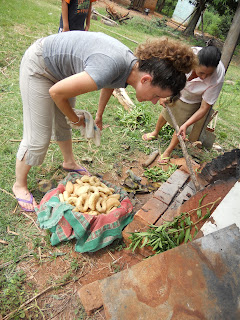As a conservation and environmental education volunteer, one of the goals of my service is to raise awareness about deforestation in Paraguay, and encourage reforestation or to simply plant more trees with the people in my community, using locally available trees and seeds. Before attempting to teach others, I wanted to do a little experimenting on my own. Here is a snapshot of the process we used to create our own little backyard, vivero, or tree nursery.
1. Mark and I, during our daily two-hour walks in our community, began to identify local trees and identify potential, “mother trees.” Mother trees are exceptional trees of a specific variety from which we might collect seeds.
2. We collected seeds from 3 different trees, including: one native, (Timbo); one popular in this area for shade, (Chivato); and one ornamental, (Lluvia de Oro).
3. We worked with our host family to correctly identify the tree varieties, then removed the seeds from their protective pods.
4. Next, we treated the seeds with boiling water, (4 minutes), and soaking with cold water, (10 hours), so the seeds would germinate more rapidly.
5. While the seeds were soaking, we made macetas, (homemade planters), out of plastic soda bottles.
6. We planted the seeds and Mark made a medio sombra, (shade), for the seedlings to protect them from the blistering Paraguayan sun.
7. Our tree “plantitas” sprouted and continue to grow under the watchful eye of Lorenzo, our 5 year-old host brother. He waters them daily with a regadera, (watering can), made from a plastic soda bottle. He also loves to use his balde and pala, (bucket and shovel), that Mark made for him out of plastic from the maceta project, (notice the recycling theme going on, here?), to spread ashes around the perimeter of our tiny vivero to deter ants.
8. Today, we transplanted the larger trees into bigger, individual macetas made from old newspapers.
We have have been learning lots about growing local trees, creating tools from available materials, and working with our host family!











